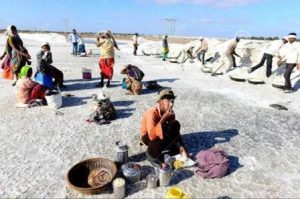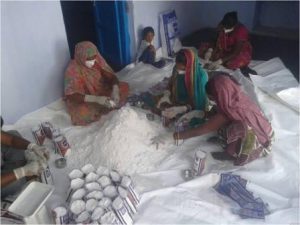Mining Salt for Living the Life of Saltpan Workers
It will cost you a minimum of 18 rupees to buy a branded packet of 1 kg salt but at the cost of saltpan workers’ inhuman working conditions.

Gujarat, Rajasthan and Tamil Nadu produce more than 96 per cent of the total salt production in the country. Gujarat monopolizes the market with 76.7 per cent share of the salt that is domestically used as well as exported. The salt industry in Gujarat employs a staggering number of 1.4 lakh labourers daily in a trade spanning across around 15 districts of Gujarat. Rann of Kutch tops the list with its highest contribution in production.
Salt is a central subject according to the Constitution of India. It means that every aspect of the salt industry is being controlled by the Centre. It diffuses chances of any intervention from state government and thus leaves the workers and industries in hands of special authorities with least priority given to it.
Salt Industry
Out of the total 3,86,851 acres said to be harvested for salt, the actual area harvested is mere 2,00,692 acres (Gujarat salt region 2010–2011). The industry faces an absolute dearth of storage facilities where a large chunk of production fails to reach the market because it turns into waste. The slow level of modernization and mechanization (harvesting, transporting, refining and packaging) ensures that the production process remains tedious and hazardous for workers.
Also Read : An Ode To Natural Salt
Impending Health Risks
Working in an unorganized sector itself invites hazards unexplainable, with no minimum basic facilities, direct monitoring and wages, saltpan workers often find themselves in turbulent conditions striving to survive each day. The plights of saltpan workers retrograde with the nature of their work.
In a study, it was found that the salt-pan workers suffer from diseases emanating because of the work they do most of their lives. Due to exposure to saline chemicals because of the non-existence of safety wear or equipment for more than 10 hours for most of their lives causes skin diseases which remain untreated for most of them for various reasons. The high temperature (reaching up to 40 degree Celsius even in colder months during daytime) under which they have to work is another occupational hazard which is not mentioned in the list of occupational hazards. Eye conditions such as deterioration of eyesight early or weak eyesight and irritability due to intense reflective off white surface over which they work is another health hazard they face regularly.
The harsh working conditions along with negligible access to medical care worsen the conditions for them.
Never-Ending Cycle of Poverty
The sale of salt in the beginning at 15 to 20 paise per kg to 15–20 rupees per kg through layers means that the beginner’s level receives least of the lucrative business. The harvester and market price difference leads to even lower wages for saltpan workers. Low wages at salt packaging factories which could be as low as 80–90 rupees per thousand packets doesn’t shine much light of hope on the already abysmal state.

They are wedged in a bottomless pit of poverty which is further aggravated by inadequate opportunities for children to get the education and create better lives for themselves and away from their parents’ trade. The region has a negligible number of schools and other educational institutes. Most of the schools are far away from the salt mines meaning long-distance travel for children. The inability of parents to pay school fees is another issue which dogs the education for children of the area. Extreme poverty also means that children are induced early in the trade and exposed to health hazards from childhood. This way, children can’t find an opening out of chronic poverty which plagued their parents and consequently, it continues through generations.
Saltpan workers live in very poor and inhuman living conditions without access to basic services and living requirements. For the most months of the year, saltpan workers live in makeshift accommodations near salt mines. These are thatched huts with no amenities such as toilets, electricity, etc. Living in close quarters of salt mines means minimal sources of drinking water. The workers depend on government tankers which arrive once a week for the supply of drinking water which could be less than the required amount.
Isolated near salt mines, access to market every day is an impossible dream to have. Lack of money to buy nutritious provisions like fruits and vegetables leads to malnutrition amongst children as well as young and old.
Piecemeal Approaches
Gujarat government had started a scheme for housing, Namak Mazdoor Awas Yojana (NMAY), for the saltpan workers. It aims to provide adequate accommodations near the salt mines for better living conditions. In 2012, 5,000 houses were sanctioned under NMAY during the 10th five-year plan.
The government had also laid out plans for model salt farms with the help of the Gujarat state government and NGOs working for the cause. The responsibility for setting up of farms was given to Central Salt and Marine Chemicals Research Institute, which reportedly established a few salt farms across the state.
Questions Unresolved
The non-existence of government action for ensuring that children in the region get education raises serious questions on the provision of compulsory education for children below the age of 14.
Also Read : Hypertension Beat The Silent Killer With Lifestyle Changes
A few NGOs are working for the cause and travels to the secluded regions to informally teach children of saltpan workers.
While discussing modern and mechanized model salt farms, it has been called a non-starter by many. The project is yet to start functioning despite the passing of such a long time since it was declared to have been established.
There is no adequate data available for the funding and houses constructed under NMAY other than the 2012 data about sanctioning of houses. However, questions have been raised over the quality of a meagre number of houses constructed under the scheme by NGOs working in the area.
Agariyas, working for the palate of Indians, will require more attention of the government for their elevation from the deprived condition that they have been cursed with. Government funding and expenditure fails to see the light of reality and thus needs to be made transparent and available for authorities concerned so that proper attention could be given.
